Lowbrow Pop Surrealism – Discover the Underground Movement
What is Lowbrow art and what does it entail? Los Angeles is one of the most culturally diverse cities in America that is also well-respected for its dynamic range of art institutions, as well as being the birthing ground of some of the world’s leading Contemporary artists. You may have heard of the Surrealist movement in art class, but have you covered the underground subcultural movement known as Lowbrow Pop Surrealism? Luckily for you, we have it covered! In this article, we will introduce you to Los Angeles’ most popular underground and subcultural art movement of the 20th century that will catch the eyes of those who prefer a sense of humor and sarcasm in Contemporary art. Read on for more about the anti-establishment and underground movement known as the Lowbrow art movement!
Contents
- 1 Exploring the Lowbrow Pop Surrealism Movement: Underground and Anti-Art Cultures
- 2 Important Artists of Lowbrow Pop Surrealism
- 3 Examples of Lowbrow Pop Surrealism Art
- 3.1 Five O’Clock Shadows in Disney-Dali Land (1996) by Todd Schorr
- 3.2 Putting The Genie Back In The Bottle (2000) by Robert L. Williams
- 3.3 Barack Obama “Hope” Poster (2008) by Shepard Fairey
- 3.4 When It Begins (2014) by Audrey Kawasaki
- 3.5 Self Portrait as Dodecahedron (2015) by Mark Ryden
- 3.6 Night Bloom (2017) by Amy Sol
- 3.7 Invasive Species (2019) by Ray Caesar
- 3.8 Not to Touch the Earth (2020) by Victor Castillo
- 3.9 Mona Leia (2022) by Alex Gross
- 4 Frequently Asked Questions
Exploring the Lowbrow Pop Surrealism Movement: Underground and Anti-Art Cultures
If you are a lover of Surrealism, popular culture, comic books, and any art form or style that presents as anti-establishment, then you will certainly enjoy the rich universe of Lowbrow Pop Surrealism. Many will recognize the term “Surrealism” by its association with artists such as Salvador Dalí or André Breton who explored the depths of the human experience through the unconscious mind. Surrealism emerged in the early 20th century and was a huge source of inspiration to many artists well into the 21st century. The foundational style of Surrealism was rooted in the combination of images or ideas in an artwork arranged or presented oddly or unconventionally. The artwork would mimic a scene that could only be derived from the imagination and as such became one of the elements that feature in the mid-20th century’s underground movement known as Lowbrow Pop Surrealism.
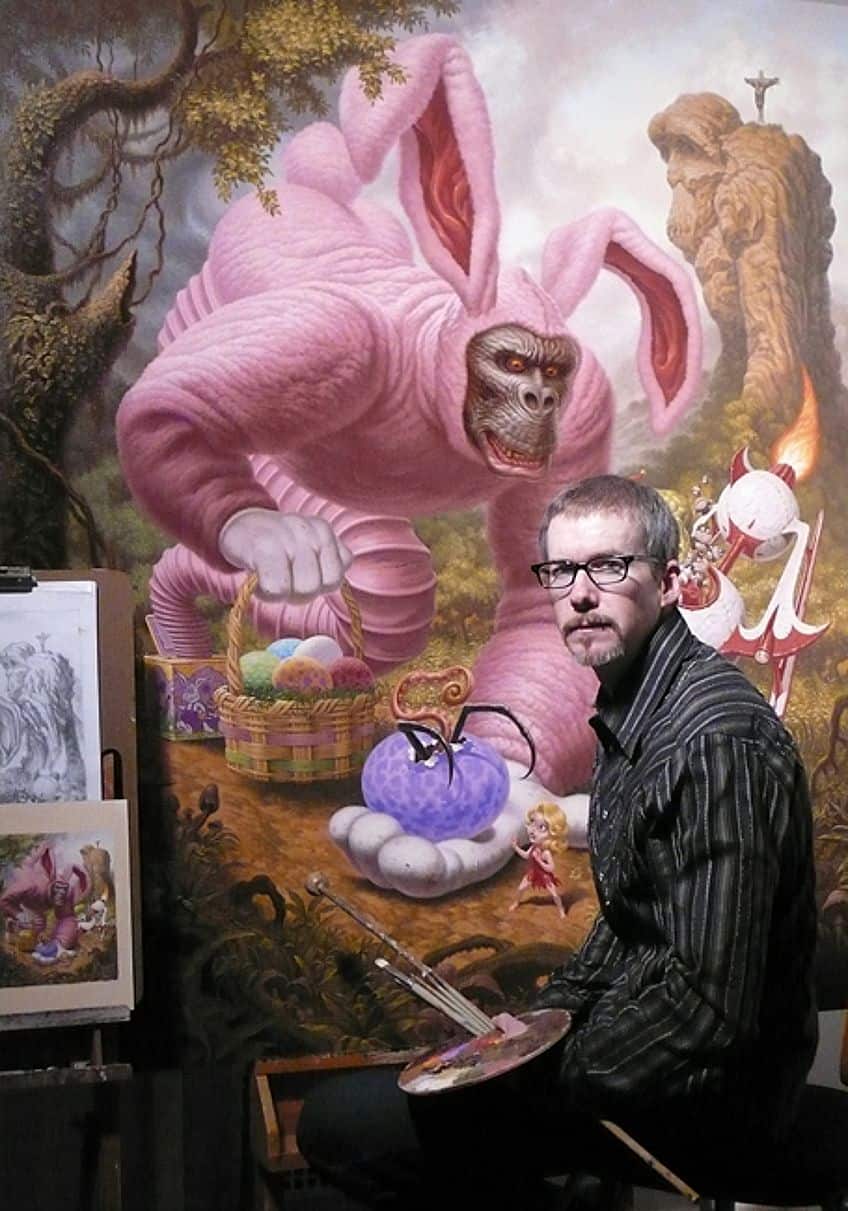
What Was the Lowbrow Art Movement?
It is easy for underground movements and artistic trends in the subcultures of major cities such as Los Angeles to go unnoticed or even unheard of, however, imaginative developments such as Lowbrow Pop Surrealism have existed since the 1960s. The term is also referred to as Lowbrow art or Pop Surrealism and is considered to be a populist movement founded on multiple cultural trends of the late 1960s California culture.
A few of these trends and urban cultures inspired the imagery found in many Lowbrow Pop Surrealist artwork and includes graffiti, street culture, hot-rod lifestyles, underground comix, tiki culture, and punk music.
One of the main defining characteristics of Pop Surrealism is the artwork’s connotations, which usually possess a level of sarcasm, gleeful humor, or public commentary. The majority of Lowbrow Pop Surrealist artists utilized mediums such as painting, sculpture, toys, and digital art tools to create eye-catching Surreal compositions with popular Lowbrow motifs.
Characteristics of Surrealism Pop Art
What is Lowbrow art? While Lowbrow art cannot be withheld to societal standards and is certainly anti-establishment, one can still identify artworks under the Lowbrow art movement by analyzing a few common characteristics of the movement and its influences. To summarize, we have compiled a list of the characteristics of Lowbrow Pop Surrealism that will help you form an in-depth understanding of the movement and the different visual approaches to the artwork classified under this movement.
- Lowbrow Pop Surrealism artworks emerged alongside the urban art form known as street art in the 20th century and include references to street culture and underground subcultures of the 1960s to 1990s.
- Artworks classified as Lowbrow Pop Surrealist art almost always make a point to set themselves apart from the norm or traditional values of a medium in art. These artworks include a fusion of art styles drawing from the past and incorporating Contemporary popular cultural references in a Surrealist manner.
- Lowbrow artworks cover themes related to humor, social criticism, political commentary, and the personal experiences of the artists who practice it.
- Art under the Lowbrow Pop Surrealist movement relied on the use of images of popular culture icons as well as sarcasm and distances itself from the realm of mainstream gallery spaces.
- The culture of Lowbrow art can be compared to an encounter with an identity crisis and is often criticized as being “kitsch”. Many Lowbrow artworks have complex compositions and can be identified by their dream-like Surrealist compositions, color schemes, and identifiable subjects.
- Other terms that one can identify Lowbrow Pop Surrealist artwork by include terms such as anti-establishment, Newbrow, Kustom, Neo-Pop, underground art, or visionary art.
- Although Lowbrow art was being produced in the 1960s, the official recognition of the movement as “Lowbrow” was coined in 1994 when pioneering painter Robert Williams established the Juxtapoz magazine, which went on to unpack the upcoming talents of Lowbrow Pop Surrealism.
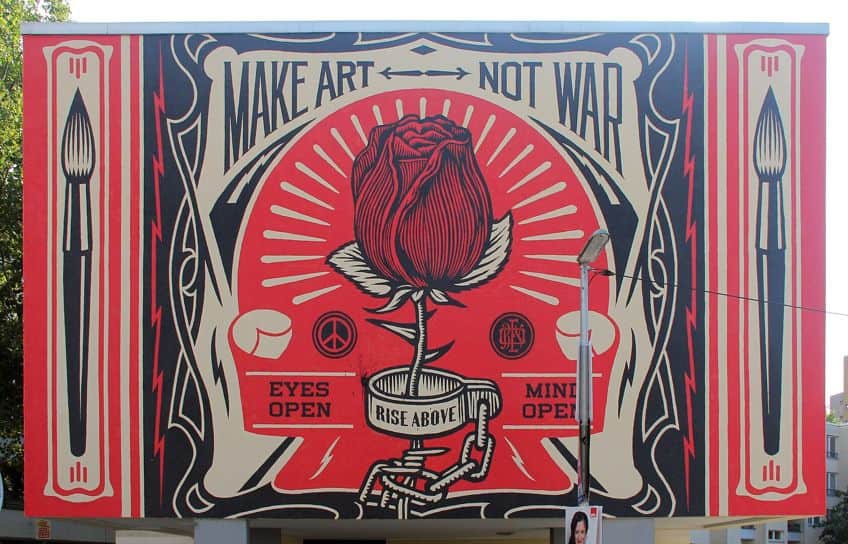
Important Artists of Lowbrow Pop Surrealism
The strange yet captivating world of Lowbrow Pop Surrealism was piloted by a group of artists who were primarily underground cartoonists in the mid-20th century. The Lowbrow Pop Surrealist movement was initially a movement that was aimed at counter-culture at the time and presented itself alongside other counter-culture art developments such as street art, graffiti art, zines, and fashion.
Like many influential art movements, the Lowbrow Pop Surrealist movement and its artists were moved by the cause of defying existing social rules around what art looked like and specifically challenging the idea of acceptable subjects.
Most of the major exhibitions of the movement were held at alternative New York and Los Angeles-based galleries amidst the critical pushback of art critics. Among the institutions that championed and popularized the movement included galleries such as Bess Cutler Gallery, Psychedelic Solutions Gallery, and Julie Rico Gallery. Below, we will introduce you to the major artists of the Lowbrow Pop Surrealist movement of the 1960s who established the roots of the movement.
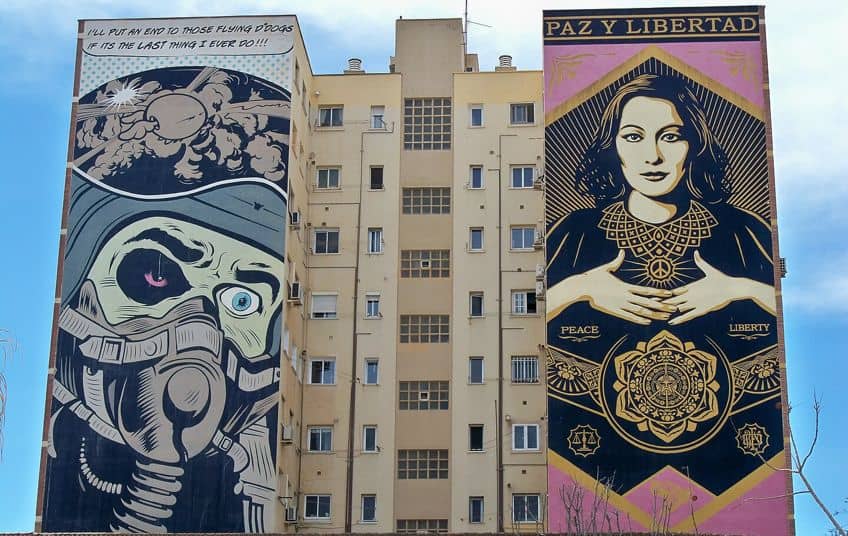
Robert L. Williams (1943 – Present)
| Artist Name | Robert L. Williams II |
| Date of Birth | 2 March 1943 |
| Date of Death | Present |
| Nationality | American |
| Associated Movements, Themes, and Styles | Feral art, Lowbrow Pop Surrealism, Lowbrow art, Conceptual Realism, Modern art, Contemporary art, psychedelic imagery, and cinematic apocalypticism |
| Mediums | Illustration, drawing, and painting |
| Famous Artworks | ● Zombie Mystery Paintings (1982) ● Messages From A Drunken Broom (1987) ● Necro Serenade’ Zombie Mystery Painting (c. 1989) ● Best Intentions (2000) |
One of the founding fathers of car culture art was Robert Williams, who also goes by the name Robt. Williams dominates the scene as one of the most popular Lowbrow Pop Surrealism artists of the century. Williams published a book on the Lowbrow art movement, which makes mention of his personal interpretation of the movement as a cartoon-influenced abstract Surrealism movement. Williams regards his work to be classified as “conceptual realism” that features psychedelic imagery with elements of cinematic apocalypticism, film noir, and California car culture. In his early art endeavors, Williams was initially referred to as an “illustrator” in a derogatory manner while studying at the former Chouinard Art Institute.
After leaving the art academy, Williams carved his own creative path and pushed forward to establish the Juxtapoz Art & Culture Magazine in addition to becoming one of the leading creators of Zap Comix.
Throughout his work, Williams draws reference to his childhood experiences informed by his love for car culture and the hot rod lifestyle. The Lowbrow artist also described his intention for his artwork as intending to trap the viewer instead of serving as a form of entertainment. He further emphasized that his preferred art movements include Feral art, exploratory Realism, and colloquial art. The co-founder of Juxtapoz, Greg Escalante, was also incredibly influential in the spread of the movement and is currently regarded as a prominent curator, art collector, and gallery owner. Together with Williams, Escalante helped launch the magazine to connect artists engaged in the fusion of hot-rod, psychedelic, and modern culture native to California. As the magazine’s reach grew, so did its inclusion of other subcultures of the underground art scene, and has since been a key catalyst for the awareness and popularization of the practice of Lowbrow art in America.

Gary Panter (1950 – Present)
| Artist Name | Gary Panter |
| Date of Birth | 1 December 1950 |
| Date of Death | Present |
| Nationality | American |
| Associated Movements, Themes, and Styles | New Wave, Contemporary art, Modern art, post-underground art, Lowbrow Pop Surrealism, and Lowbrow art |
| Mediums | Cartoon illustration, painting, design, and music production |
| Famous Artworks | ● Untitled (1978) ● Signed Gary Panter La Maravilla Enmascarada (1986) ● Untitled (1995) ● Bunny City 126 (2020) |
Gary Panter is one of the most famous Lowbrow Pop Surrealism artists of the 20th century who is also a cartoonist, designer, painter, and post-underground artist. Panter was also part of the New Wave comics movement having published his works in Raw and Rolling Stone magazines. The multi-talented artist also bagged three Emmy awards for his contribution to the set design for Pee-wee’s Playhouse in the 1980s.
Panter’s works reflect his punk flair approach to painting while bringing a unique balance across commercial art, cartoon illustration, and music.
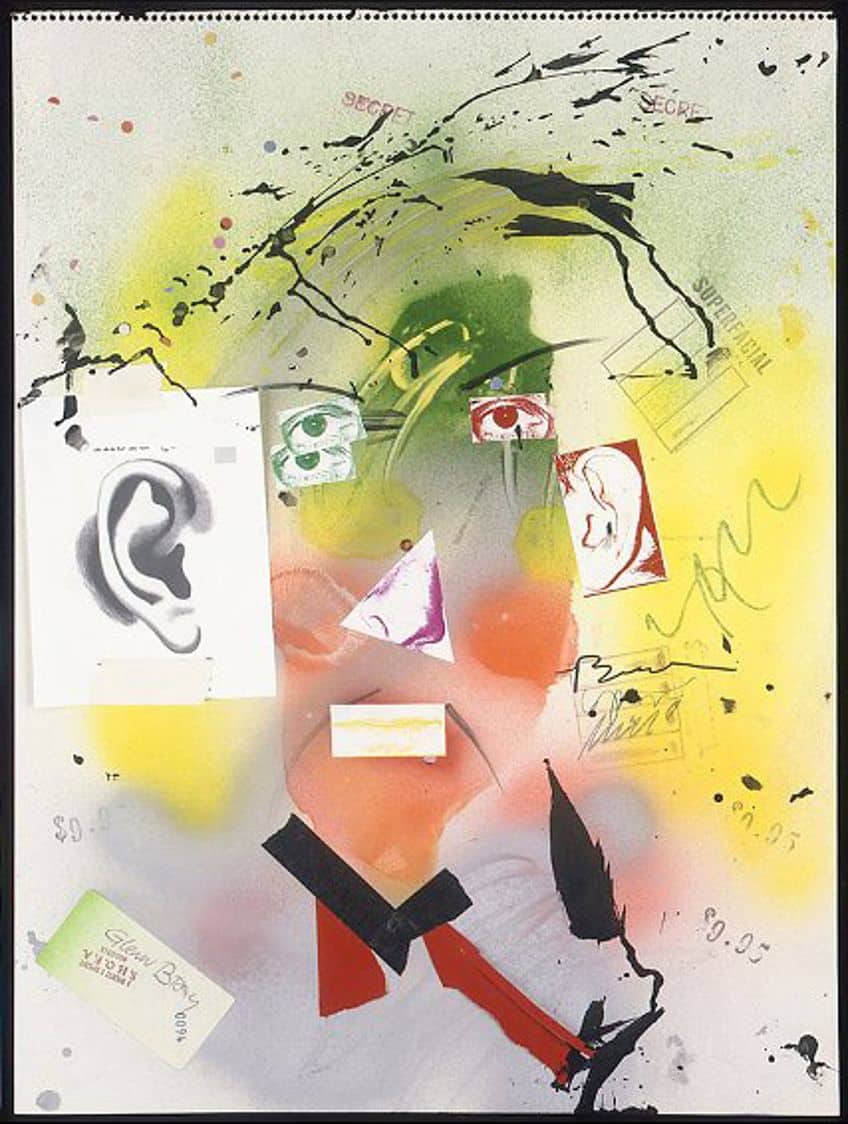
Marion Peck (1963 – Present)
| Artist Name | Marion Peck |
| Date of Birth | 3 October 1963 |
| Date of Death | Present |
| Nationality | American |
| Associated Movements, Themes, and Styles | Lowbrow art, Pop Surrealism, Modern art, and Contemporary art |
| Mediums | Painting |
| Famous Artworks | ● Mouse Lady (2016) ● Girl With Cat Eye Glasses (2018) ● Man with a Ruff (2018) ● Girl With a Daisy (2018) |
Born in Seattle, Pop Surrealist Marion Peck is among the most popular Lowbrow artists of the 21st century whose works have been exhibited internationally. Peck’s work has been featured in album designs for bands such as Sophe Lux in addition to a collaborative publication with her spouse Mark Ryden. Peck graduated from the Rhode Island School of Design in the 80s and has since leveraged her experience from living in Italy to enhance her Pop Surrealist paintings.
Peck’s Lowbrow paintings have been exhibited across Europe and America and display a fairytale-like quality that showcases the artist’s unique imaginative interpretations of her inner world.
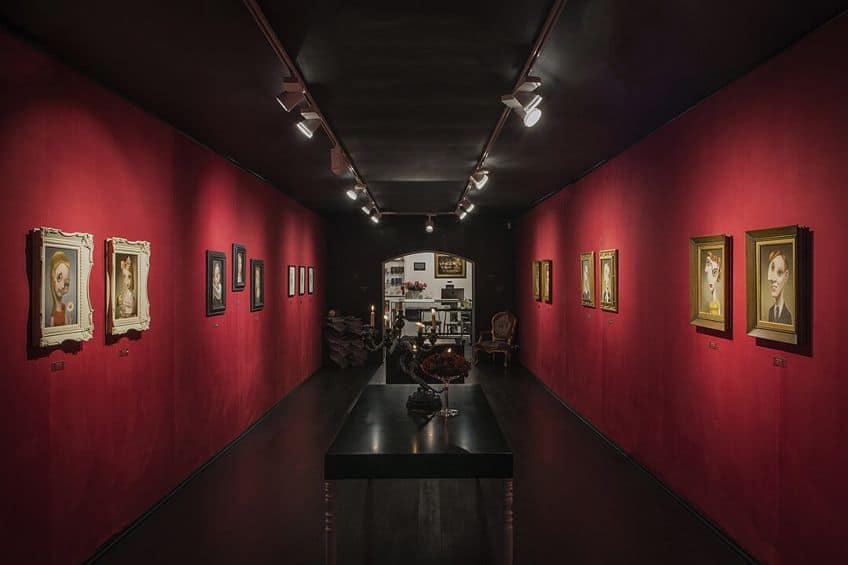
Shepard Fairey (1970 – Present)
| Artist Name | Frank Shepard Fairey |
| Date of Birth | 15 February 1970 |
| Date of Death | Present |
| Nationality | American |
| Associated Movements, Themes, and Styles | Street art, Contemporary art, Lowbrow Pop Surrealism, and Public art |
| Mediums | Painting, stenciling, illustration, and design |
| Famous Artworks | ● Barack Obama “Hope” Poster (2008) ● Rise Above Rebel (2016 – 2020) ● We the People are Greater than Fear (2017) ● Defend Dignity (2017) |
Shepard Fairey, who is better known in the Lowbrow Pop Surrealism art scene as Dan “Plasma” Rauch, created many iconic street artworks in the mid-20th century. Fairey executed an alternative approach to early street art through wheat-pasted posters and stickers. His works are inspired by Constructivism, which also carries humanitarian messages of inspiration and sometimes covers issues related to the United States political landscape. Fairey was also referenced in popular culture television shows such as the Simpsons as well as his artwork was included on various magazine covers. The popular Lowbrow street artist was also arrested around 14 times for creating his public artworks.
Today, he is still celebrated as one of the leading revolutionary thinkers of punk anarchist visual aesthetics associated with Lowbrow Pop Surrealism.
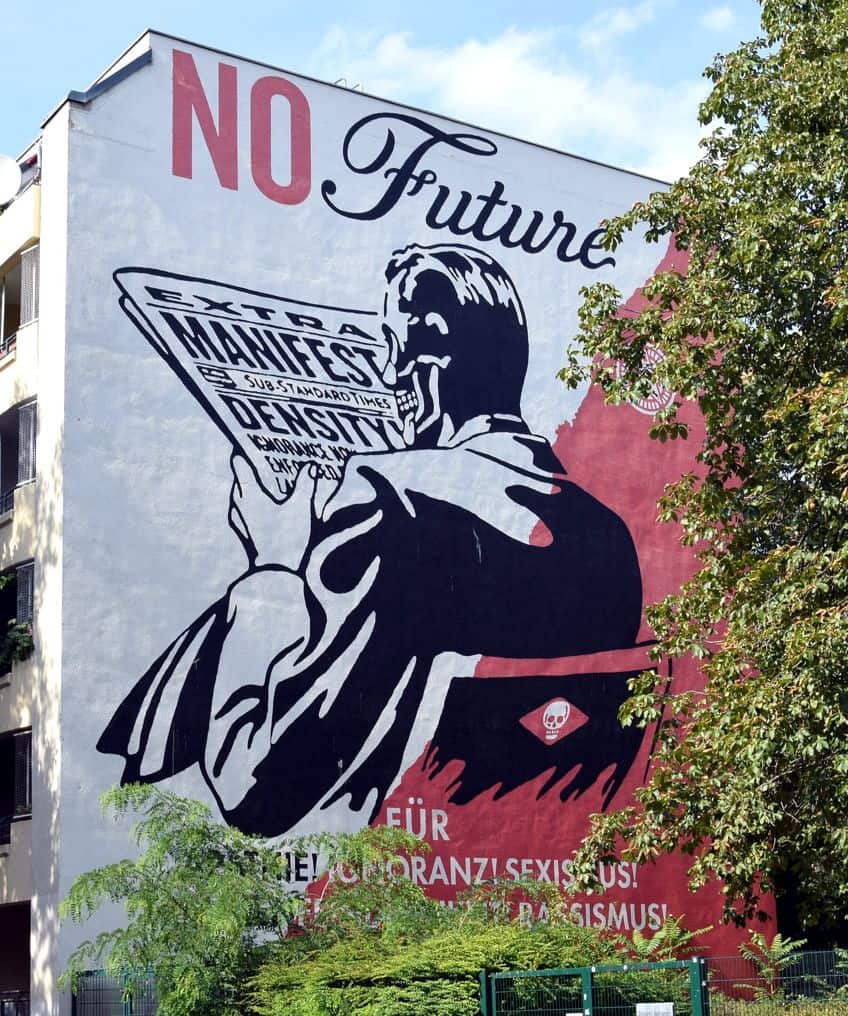
Camille Rose Garcia (1970 – Present)
| Artist Name | Camille Rose Garcia |
| Date of Birth | 18 November 1970 |
| Date of Death | Present |
| Nationality | American |
| Associated Movements, Themes, and Styles | Lowbrow Pop Surrealism, Modern art, Neo-Pop art, and Contemporary art |
| Mediums | Painting |
| Famous Artworks | ● Hippo Baby Blood Storm (2004) ● Exploding Twilight Skies (2007) ● Down The Rabbit Hole (2009) ● The Hydra of Babylon (2009) |
Sculptor and painter Camille Rose Garcia is a popular Contemporary Lowbrow Pop Surrealist who creates other-worldly artworks that showcase a fusion of gothic-inspired characters with mysterious cartoon-styled elements. Garcia also includes images of popular fictional characters in her work, layered in interesting ways to evoke curiosity in the viewer and stir a sense of attraction to supernatural creatures. Drawing from Fleischer animations, her imagination, and Disney, many of Garcia’s paintings have been featured in prominent magazines, including the Modern Painter and the Rolling Stone.
Today, her works can be found in the collections of institutions such as the San Jose Museum of Art and the Los Angeles County Museum.
Other prolific Lowbrow Pop Surrealism artists to explore include figures such as Gary Baseman, Audrey Kawasaki, Billy Shire, Greg Simkins, Amy Sol, and many more brilliant multi-talented Contemporary artists. Major supporting galleries of the movement include The Sparks Gallery, Baton Rouge Gallery, Gristle Art Gallery, AFA Gallery, The Hive Gallery and Studios, and the La Luz de Jesus Gallery.
Examples of Lowbrow Pop Surrealism Art
The subgenre of Lowbrow art known as Pop Surrealism was pioneered by Kenny Scharf who managed to express comical and pop imagery from his subconscious in his paintings. Below, we will dive into some famous examples of Surrealism Pop artwork that will have you fascinated and intrigued by the many imaginative ways in which the art styles of the movement took shape throughout the 20th and 21st centuries.

Five O’Clock Shadows in Disney-Dali Land (1996) by Todd Schorr
| Artist Name | Todd Schorr (1954 – Present) |
| Date | 1996 |
| Medium | Acrylic on canvas |
| Dimensions (cm) | 76.2 x 101.6 |
| Where It Is Housed | Petit Ermitage, California, United States |
Todd Schorr is a famous Lowbrow Pop Surrealist member whose visual language in the movement was inspired by polish-finished cartoon imagery combined with various painting styles of popular painting masters. Schorr’s works explore the human condition through detailed and saturated compositions, which transport the viewer into unrecognizable dimensions and bring to life imagined scenes inspired by familiar styles.
Five O’Clock Shadows in Disney-Dali Land is one of the most famous Lowbrow Pop Surrealism paintings, which can be viewed at the Petit Ermitage in West Hollywood.
The acrylic painting portrays two familiar icons of Surrealism and Pop art, Salvador Dalí and Walt Disney engaged in a face-off battle. The painting style was executed in Dalí fashion with references to Disney’s castle, the character Mickey Mouse, and Dalí’s self-portrait and color palette. The painting may seem strange at first glance, but under the Lowbrow Pop Surrealist movement, its composition and many references to popular culture and Surrealism make sense.
Putting The Genie Back In The Bottle (2000) by Robert L. Williams
| Artist Name | Robert L. Williams (1943 – Present) |
| Date | 2000 |
| Medium | Oil on canvas |
| Dimensions (cm) | 76.2 x 91.4 |
| Where It Is Housed | Tony Shafrazi Gallery, New York City, United States |
Putting The Genie Back In The Bottle is among one of the most famous Lowbrow paintings by Robert L. Williams, which illustrates a group of individuals attempting to return a blue-faced genie to his lamp. Among the group appears to be a scientist, a woman in red, a man wearing a construction safety helmet, and another man overseeing the operation. In the background, there appears to be a giant machine with a large iron fist as well as another Arabian-looking landscape under the evening sky on the left half of the painting.
The bizarre scene is certainly surreal as the viewer is plunged into multiple scenes while confronting a creature that one might only encounter in fairy tales such as Aladdin.
Barack Obama “Hope” Poster (2008) by Shepard Fairey
| Artist Name | Shepard Fairey (1970 – Present) |
| Date | 2008 |
| Medium | Multimedia poster; screen-print, digital illustration, and stickers |
| Dimensions (cm) | Varied |
| Where It Is Housed | National Portrait Gallery, Smithsonian Institution, Washington, D.C., United States |
The iconic presidential campaign poster for Barack Obama was designed in 2008 by Shepard Fairey who at the time was heavily invested in street art that engaged in political critique. The stylized stencil image of Barack Obama quickly became the face of Obama’s campaign and featured solid colors of beige, red, blue, and white with the words hope or progress below and other variant posters with different texts to uplift and promote Obama’s campaign. The design was based on an image shot by Mannie Garcia and first debuted in the public as a street poster.
The image quickly gained traction in its distribution and by July 2008, the poster was transformed into over 200,000 vinyl stickers, which were then distributed in support of the campaign.
According to design academic Steven Heller, the poster was informed by Social Realism associated with a Contemporary trend in 21st-century artists adopting new tones and styles when creating works with political candidates. Throughout the campaign, Fairey also produced and sold many screen prints of the design with a total of more than one million stickers that were printed and distributed. In addition to the amount of positive feedback from Obama supporters on the design and distribution of the work, Fairey’s poster also caught the eye of parody artists and anti-Obama groups who swapped the text “hope” for “hype” under the Obama portrait.
When It Begins (2014) by Audrey Kawasaki
| Artist Name | Audrey Kawasaki (1982 – Present) |
| Date | 2014 |
| Medium | Oil, graphite, and ink on wood panel |
| Dimensions (cm) | 50.8 x 91.4 x 5.1 |
| Where It Is Housed | Private collection |
Audrey Kawasaki is a famous Lowbrow Pop Surrealist artist who is based in Los Angeles and is most famous for her unique compositions informed by erotic figures of young women in fantasy-like antique settings. Kawasaki portrays the innocence of being watched while executing delicate figures of women softly and gently. Kawasaki’s paintings are also reminiscent of Japanese woodblock print imagery with her use of muted flat colors and floral motifs. When It Begins is executed in the same manner with a young woman who appears naked before the viewer but is aware that she is being observed. Her body language suggests a shy demeanor toward the viewer as a flock of birds fly past her in a forest landscape.
Other stunning paintings by Kawasaki include Murmur (2014), CHARMED (2018), and Claire de Lune (2019).
Self Portrait as Dodecahedron (2015) by Mark Ryden
| Artist Name | Mark Ryden (1963 – Present) |
| Date | 2015 |
| Medium | Bronze |
| Dimensions (cm) | 102.9 x 134.9 x 134.9 |
| Where It Is Housed | Kasmin, New York City, United States |
Mark Ryden is another highly celebrated Lowbrow painter and sculptor whose works reflect many surrealist elements from popular culture, including strange-looking Victorian children and cartoon characters that appear straight from his imagination. Ryden’s work is also characterized by ornate frames, carved with classical detail, and amplifies the Pop Surrealist’s creations humorously. Ryden has exhibited his creations around the world with many of his works collected by institutions such as the Los Angeles County Museum of Art. Self Portrait as Dodecahedron is a large bronze sculpture of a three-dimensional dodecahedron object presented as Ryden’s self-portrait. The sculpture makes no direct reference to the artist’s physical identity, yet it contains specific motifs, which make the work incredibly Surreal and fascinating to view. The sculpture possesses 12 flat surfaces and 30 edges and was based on the structure of the pentagonal dodecahedron.
The structure itself is said to be quite special as it represents the universe and is recognized as one of the five Platonic solids or one of five elements.
Night Bloom (2017) by Amy Sol
| Artist Name | Amy Sol (1981 – Present) |
| Date | 2017 |
| Medium | Oil on paper |
| Dimensions (cm) | 22.9 × 30.5 |
| Where It Is Housed | Haven Gallery, New York, United States |
Night Bloom is one of Amy Sol’s Pop Surrealist creations that showcase her eye for fantasy and childhood experiences captured through images of young girls set against floral compositions or natural landscapes. Her works are executed with a sense of delicacy and benevolence toward her fictional characters. Sol is an American Lowbrow artist with Korean ancestry, which is mirrored in her works through a few of her characters who were inspired by characters from Eastern and Western popular culture films and movies.
Sol’s images not only evoke the calm visuals of idyllic beauty but also inspire a magical atmosphere and force the viewer into a reflective state.
Sol’s graphic artistic qualities were inspired by Studio Ghibli movies and the idealistic worlds of American illustration and Disney works. Night Bloom illustrates a portrait of a young girl reading a book in front of the viewer and positioned as if emerging from a flowery background. She is accompanied by two birds on either side of her shoulders and appears invested in the book, perhaps unaware of her position of being watched. The painting carries a mysterious, calm, and melancholic atmosphere, which reminds one of death due to the stillness of the young girl and the pale white flowers that illuminate the work more than the young girl herself.
Invasive Species (2019) by Ray Caesar
| Artist Name | Ray Caesar (1958 – Present) |
| Date | 2019 |
| Medium | Digital Ultrachrome on archival paper; paint and varnish on panel |
| Dimensions (cm) | 50.8 x 61 |
| Where It Is Housed | Gallery House, Toronto, Canada |
Ray Caesar is considered to be one of the most iconic Lowbrow Pop Surrealist artists of the 20th century who leveraged his background in digital animation in the film and television industry of the 1990s to create many intriguing digital visuals that evoke childhood memories and creations of the subconscious. Caesar is inspired by the works of Jean-Antoine Watteau, Lisa Yuskavage, and John Currin, to create caricatures with a sense of glamor that addresses difficult emotions in subtle and beautiful ways. Caesar makes it a point to include elements in his compositions to throw the viewer off and question the role of certain objects in the work that appear disturbing or out of place. Some of his paintings evoke themes of taboo, melancholy, and sadness while including specific symbols and objects such as clocks, silk dresses, irons, and scissors with additional details for added Surrealism. Invasive Species is a composition that appears as though it is a scene from a space dream or dystopian universe.
Here, a human figure is encapsulated in a viral vessel and is surrounded by floating organic structures that resemble flowers. The glowing green atmosphere of the painting is contrasted by the vivid red viral vessel and gives the scene an ominous feeling.
Not to Touch the Earth (2020) by Victor Castillo
| Artist Name | Victor Castillo (1973 – Present) |
| Date | 2020 |
| Medium | Acrylic on canvas |
| Dimensions (cm) | 90 x 90 |
| Where It Is Housed | Private collection |
Influenced by the old Spanish masters of art, Chilean artist Victor Castillo is one of the most well-known 21st-century Pop Surrealist painters whose works feature long-nosed characters reminiscent of Pinocchio. His works were informed by his experience of feeling disillusioned from Chile and his experience of art school. Many of Castillo’s paintings also include nostalgic imagery from vintage comics and feature children with blank-looking eyes as the protagonists in his compositions. Castillo’s work has been critiqued as “satanic” or particularly “dark” for the disillusioned representations of children, yet the artist denies any affiliations with the critiques and promotes the accessibility of art. Castillo’s Lowbrow Pop Surrealist paintings are unique and powerful as they tackle Contemporary political issues through a post-apocalyptic Pop Surrealist lens.
A few other interesting works by Castillo include Ouch! (2016) and Let’s Get Out of Here (2017).

Mona Leia (2022) by Alex Gross
| Artist Name | Alex Gross (1968 – Present) |
| Date | 2022 |
| Medium | Oil on canvas |
| Dimensions (cm) | 91.4 x 61 |
| Where It Is Housed | Artist’s collection |
The Mona Leia is a recent Lowbrow Pop Surrealist painting by Alex Gross, who is one of the best Contemporary Lowbrow artists to date. This cheeky painting is based on the fusion of the Star Wars franchise character Leia Skywalker with the face of the world’s most famous woman in art history, the Mona Lisa (1503) by Leonardo da Vinci. Here, the sitter Mona Lisa is removed from her traditional historical place as a model for Da Vinci and placed in a vibrant fictional setting, donning bright red lipstick and funky eyeliner. It is as though the ghost of Mona Lisa seems happier in her new Pop Surrealist environment than in her original role in the 16th century. Alex Gross has been featured in major Pop Surrealist literature giants, including Juxtapoz and Beautiful Bizarre publications.
The Lowbrow art movement enabled artists to explore alternative themes for representation through the unique fusion of individual and underground subcultures. The influence of Surrealism and popular culture on the different Contemporary art styles is evident in the many imaginative creations of 21st-century Lowbrow artists, and engages one in questions around the limits of the subconscious and the importance of exploring how popular culture has infiltrated the psyche. We hope that this article has gotten you excited about the world of Lowbrow Pop Surrealism and the many ways in which one can let one’s imagination run free!
Frequently Asked Questions
What Is Lowbrow Pop Surrealism?
Lowbrow Pop Surrealism is a mid-20th-century art movement founded on the principles of anti-establishment and underground art. The Lowbrow movement is also referred to as Pop Surrealism or Lowbrow art, and originated in Los Angeles with the fusion of subcultures that revolved around punk music, hot-rod culture, tiki culture, graffiti, street art, and comix.
What Are the Main Themes in Lowbrow Pop Surrealism Art?
The main themes in Lowbrow Pop Surrealism art include sarcastic commentary or matters related to politics that prioritize the expression of humor while highlighting societal gaps. Other themes explore popular culture and Surrealist art styles in painting, digital art, and sculpture that are fueled by ideas from the artist’s subconscious and unique perspective of the world.
Which Artists Are Associated with the Lowbrow Pop Surrealism Movement?
Leading artists associated with the Lowbrow Pop Surrealism movement include Robert L. Williams, Ed Roth, Camille Rose Garcia, Ray Caesar, Alex Gross, Todd Schorr, Shepard Fairey, Marion Peck, and Gary Panter.
Jordan Anthony is a Cape Town-based film photographer, curator, and arts writer. She holds a Bachelor of Art in Fine Arts from the University of the Witwatersrand, Johannesburg, where she explored themes like healing, identity, dreams, and intuitive creation in her Contemporary art practice. Jordan has collaborated with various local art institutions, including the KZNSA Gallery in Durban, the Turbine Art Fair, and the Wits Art Museum. Her photography focuses on abstract color manipulations, portraiture, candid shots, and urban landscapes. She’s intrigued by philosophy, memory, and esotericism, drawing inspiration from Surrealism, Fluxus, and ancient civilizations, as well as childhood influences and found objects. Jordan is working for artfilemagazine since 2022 and writes blog posts about art history and photography.
Learn more about Jordan Anthony and about us.
Cite this Article
Jordan, Anthony, “Lowbrow Pop Surrealism – Discover the Underground Movement.” artfilemagazine – Your Online Art Source. October 13, 2023. URL: https://artfilemagazine.com/lowbrow-pop-surrealism/
Anthony, J. (2023, 13 October). Lowbrow Pop Surrealism – Discover the Underground Movement. artfilemagazine – Your Online Art Source. https://artfilemagazine.com/lowbrow-pop-surrealism/
Anthony, Jordan. “Lowbrow Pop Surrealism – Discover the Underground Movement.” artfilemagazine – Your Online Art Source, October 13, 2023. https://artfilemagazine.com/lowbrow-pop-surrealism/.



